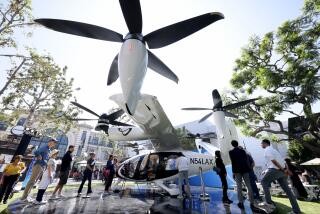New Boeing transport plane could keep Long Beach plant open
- Share via
Southern California’s last major airplane factory, slated to close in two years, could find new life under a bold plan being floated by Boeing Co. to build a new version of the massive C-17 military cargo plane.
The proposal, gaining traction among Pentagon planners, calls for transforming the long-haul, strategic transport into a tactical aircraft that could deliver equipment and supplies directly to the battlefield.
The upgraded C-17, if approved by the Pentagon, could help keep the sprawling Long Beach production line open for another decade or more, Boeing executives said. The factory next to Long Beach Airport employs about 5,000 workers.
With no new orders, the plant is scheduled to close with the rollout of the last C-17 in August 2010, dealing a major economic blow to the region. Southern California was once the nation’s aviation center, but most aircraft manufacturing plants have shuttered or moved elsewhere.
In addition to the direct payroll, the plant provides jobs for about 5,300 workers at suppliers around the region.
“We’ve got a fantastic solution,” said Jean Chamberlin, head of Boeing’s C-17 program in Long Beach. “We’ll be able to fulfill the future airlift needs of the Army and have the opportunity to extend the life of the plant well into the next decade.”
The proposal has the support of California’s congressional delegation but is likely to encounter resistance from other states that don’t have the same vested interest.
“The C-17 upgrade has tremendous potential if we can do so at a reasonable price,” said Rep. Dana Rohrabacher (R-Huntington Beach), whose 46th District includes the Long Beach plant. He was briefed on the proposal by Boeing executives Friday.
But Rohrabacher added that obtaining funding for the C-17 had always been a “knockdown, drag-out fight,” and he didn’t expect anything different for the new proposal. “It’ll be tough.”
The four-engine plane has been a workhorse for the U.S. military, transporting troops, supplies and casualties in Afghanistan and Iraq as well as conducting humanitarian supply missions after natural disasters.
Boeing has built 190 C-17s since production began in the early 1990s. The program is one of the company’s largest, generating $3 billion in annual sales.
But with tight Pentagon budgets, squeezed by the cost of operations in Iraq and Afghanistan, the Air Force has obtained funding for only 15 more, with the last C-17 slated to enter service in late 2010.
Facing that production shutdown, Boeing engineers have come up with a proposal to build a modified C-17 that would have more powerful engines, larger wing flaps and an additional landing gear.
The structural changes would allow the C-17B, as it is being dubbed, to take off and land on shorter, unprepared runways.
It would turn the large aircraft into a tactical cargo plane capable of delivering armored vehicles and troops directly to the battlefield, similar to the role played by the smaller, propeller-driven C-130 transport. Because of its size, the C-17 typically uses longer runways that are far from the battlefield.
“It would be able to deliver combat-ready vehicles like the Stryker directly to the combat zone,” Chamberlin said.
The C-17B could meet the Army’s requirement for a larger tactical airlifter without having to spend billions of dollars developing one, said Richard Aboulafia, an aerospace analyst with Teal Group Corp.
The Army is developing a variety of weapon systems, several of which would not fit or would have to be taken apart for transport in the smaller C-130. The Army, therefore, has been pushing for a new, larger plane that could deliver the next-generation equipment.
The C-17B “will be more expensive per unit but you won’t have to spend $10 billion developing a new plane,” Aboulafia said. “This is a respectable argument for keeping the production line going.”
Boeing executives said the new variant could be built for about the same cost as the $200-million C-17, even with the new engines and other upgrades, because of the savings the firm would realize from new manufacturing processes.
The C-130, built by Lockheed Martin Corp., costs about $50 million but has a maximum cargo capacity of 42,000 pounds, compared with 170,000 pounds for the larger C-17.
Still, the Air Force’s initial response was tepid.
“Right now, I don’t really see it fitting in,” Gen. Arthur Lichte, commander of Air Mobility Command, said last fall when the idea was first raised by Boeing.
But in recent weeks, top Air Force officials seemed to waver a bit, saying during a background briefing this week that the C-17B could be an alternative to developing a new tactical aircraft to replace the C-130.
Either way, Air Force and Boeing officials said any decision to proceed with building the new transport would have to wait until two major Pentagon reports were completed early next year. The reports will assess the military’s air transport requirements and recommend what type of aircraft the Pentagon may need.
“We’ve had very favorable responses,” Chamberlin said. “We’ve had numerous discussions with both the Army and the Air Force, and I think they understand its capabilities and its affordability.”
More to Read
Inside the business of entertainment
The Wide Shot brings you news, analysis and insights on everything from streaming wars to production — and what it all means for the future.
You may occasionally receive promotional content from the Los Angeles Times.










